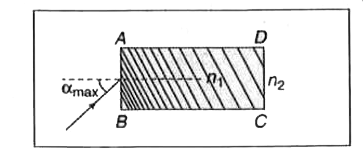A rectangular glass slab ABCD of refractive index n1 is immerged in water of refractive index n2(n1>n2) . A ray of light is incident at the surface AB of the slab as shown . The maximum value of the angle of incidence αmax , such that the ray comes out only from the other surface CD , is given by :-
_E01_205_Q01.png) Solution in Gujrati
Solution in Gujrati
sin−1[n1n2cos(sin−1.n2n1)]
sin−1[n1cos(sin−1.1n2)]
sin−1(n1n2)
sin−1(n2n1)
The correct Answer is:A
Rays come out only form CD , means rays after refraction from AB get total internally reflected at AD .
_E01_205_S01.png)
From the figure :
r1+r2=90∘
r1=90∘−r2
(r1)max=θC
[for total internal reflection at AD]
where sinθC=n2n1orθC=sin−1(n2n1)
∴(r1)max=90∘−θC
Now applying Snell's law at face AB:
n1n2=sinαmaxsin(r1)max=sinαmaxsin(90∘−θC)=sinαmaxcosθC
or sinαmax=n1n2cosθC
∴αmax=sin−1[n1n2cosθC]=sin−1[n1n2cossin−1(n2n1)]
Topper's Solved these Questions
- GEOMETRICAL OPTICSBOOK - ALLEN CHAPTER - GEOMETRICAL OPTICSEXERCISE - MCQ
5 Videos
- GEOMETRICAL OPTICSBOOK - ALLEN CHAPTER - GEOMETRICAL OPTICSEXERCISE - MATCHING
2 Videos
- GEOMETRICAL OPTICSBOOK - ALLEN CHAPTER - GEOMETRICAL OPTICSEXERCISE - EXERCISE-05 (A)
35 Videos
- CURRENT ELECTRICITYBOOK - ALLEN CHAPTER - CURRENT ELECTRICITYEXERCISE - EX.II
66 Videos
- GRAVITATIONBOOK - ALLEN CHAPTER - GRAVITATIONEXERCISE - EXERCISE 4
9 Videos
Similar Questions
A ray of light travelling in a transparent medium falls on a surface separating the medium from air at an angle of incidence of 45 degree. The ray undergoes total internal reflection. If n is the refractive index of the medium with respect to air, select the possible value (s) of n from the following:
View SolutionAn optical component and an object S placed along its optic axis are given in Column I . The distance between the object and the component can be varied. The properties of images are given in Column II . Match all the properties of images from Column II with appropriate components given in Column I.
_E01_239_Q01.png)
View SolutionIf two mirrors are kept at 60∘ to each other, then the number of images formed by them is ......
View SolutionIn the Bohr's model of hy drogen atom, the electron moves around the nucleus in a circular orbit of radius 5×10−11m. Its time period is 1.5×10−16s. The current associated with the electron motion is:-
View SolutionAssertion : The difference in the value of acceleration due to gravity at pole and equator is proportional to square of angular velocity of earth.
Reason : the value of acceleration due to gravity is minimum at the equator and maximum at the pole.
View SolutionA rectengular glass slab ABCD of refractive index n_1 is immersed in water of refractive index n_2(n_1gtn_2) . A ray of light is incident at the surface AB of the slab as shown. The maximum value of the angle of incidence alpha_max such that the ray comes out only from the other surface CD is given by
View SolutionA rectangular slab ABCD, of refractive index n_1 , is immersed in water of refractive index n_2(n_1 lt n_2) . A ray of light is incident at the surface AB of the slab as shown in Fig. Find the maximum value of angle of incidence alpha_(max) , such that the ray comes out only from the other surface CD.
View SolutionA rectangular glass slab ABCD of refractive index n1 is immersed in water of refractive index n2(n1<n2). A ray of light is incident at the surface AB of the slab as shwon. The maximum value of the angle of incidence αmax such that the ray comes out from the other surface CD is given by

View SolutionA rectangular glass slab ABCD of refractive index n1 is immerged in water of refractive index n2(n1>n2) . A ray of light is incident at the surface AB of the slab as shown . The maximum value of the angle of incidence αmax , such that the ray comes out only from the other surface CD , is given by :-
_E01_205_Q01.png)
View SolutionA ray of light is incident on a glass slab making an angle of 30^@ with the surface. The angle of refraction in glass, if the refractive index of flass is 1.6 , is
View SolutionA ray of light is incident on a glass slab of refractive index 1.5, making an angle of 40^(@) with the surface. The angle of refraction in glass is
View Solutionअपवर्तनांक n1 की एक आयताकार काँच पट्टिका ABCD, अपवर्तनांक n2 के पानी में डुबाई जाती है (n1>n2) | एक प्रकाश किरण पट्टिका के पृष्ठ अब पर आपतित होती है | आपतन कोण का वह अधिकतम मान αmax' जिसके लिए निर्गत किरण दूसरे पृष्ठ CD से बाहर आए, होना चाहिए

View SolutionA ray of light is incident at an angle of incidents 60^(@) on a transparent glass slab. The angle between the reflected ray and the refracted ray is 90^(@) . What is the refractive index of the slab?
View SolutionA rectangular glass slab ABCD of refractive index n_1 is immersed in water of refractive index n_2(n_1 gt n_2) A ray of light is incident at the surface AB of the slab as shown. The maximum value of the angle of incidence a_(max) such that the ray comes out only from the other surface CD, is given by
View SolutionA glass slab made of a material of refractive index n1 is kept in a medium of refractive index n2. A light ray is incident on the slab. Draw the path of the rays of light emerging from the glass slab, if (i) n1>n2 (ii) n1=n2 (iii) n1<n2.
View Solution
